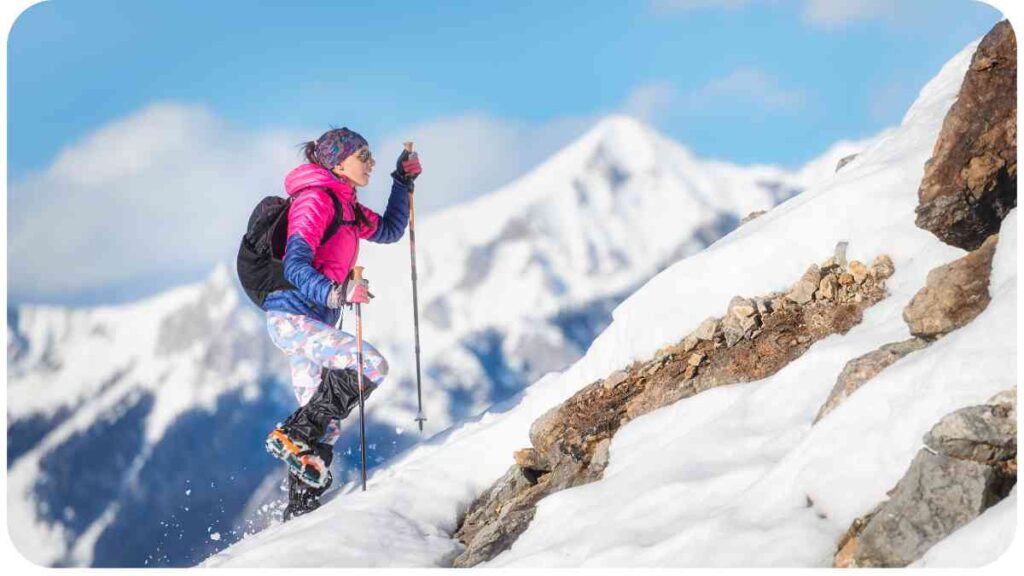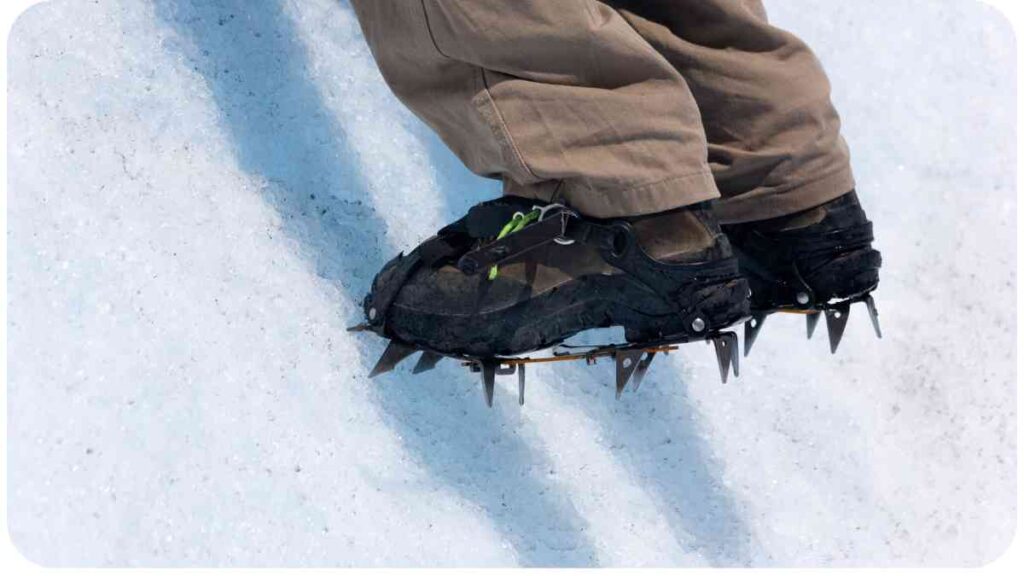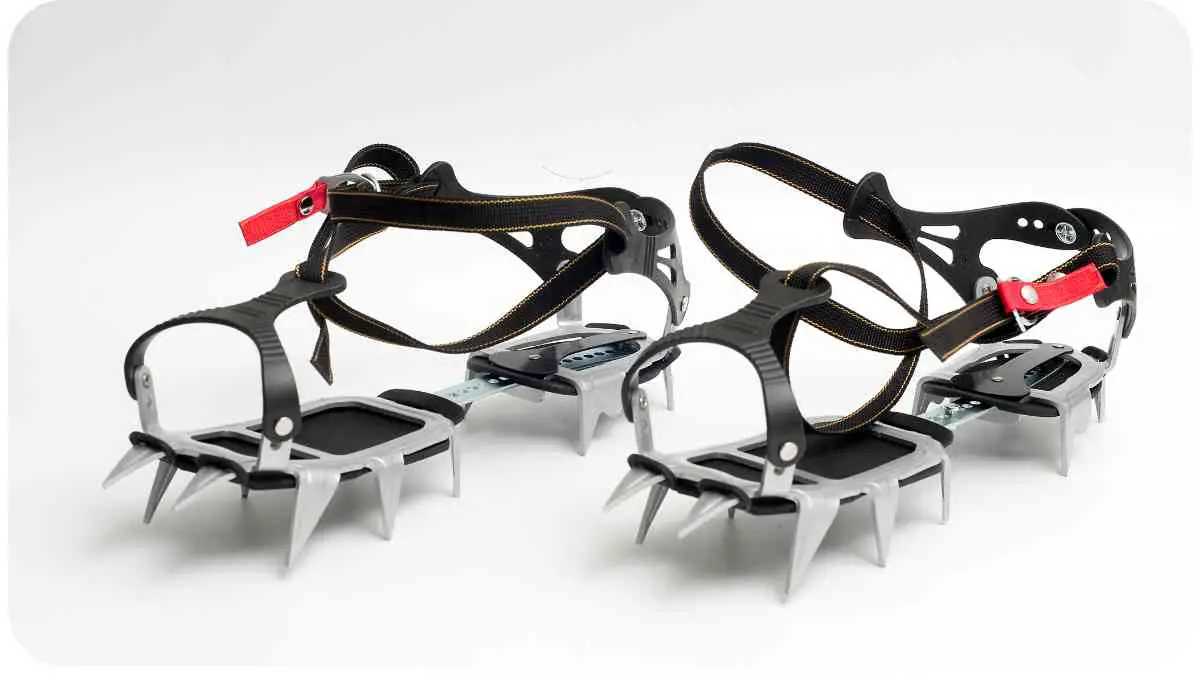Welcome to this guide on resolving crampon attachment issues and ensuring a secure fit. Crampons are essential tools for mountaineering, ice climbing, and other vertical adventures, providing traction on icy or snowy terrain.
However, achieving a proper and secure fit with your crampons is critical for safety and efficiency. In this article, we will delve into the various factors that can affect crampon attachment, troubleshooting common problems, and providing practical tips to help you find the perfect fit.
| Takeaways |
|---|
| Proper fitting of crampons is crucial for safety and performance in mountaineering. |
| Consider boot compatibility, size selection, and adjustment of strap tension for a secure fit. |
| Choose crampons with frame shapes and spike configurations that match the terrain you’ll be traversing. |
| Regularly inspect and maintain your crampons to ensure optimal functionality and safety. |
| Invest in high-quality crampons for durability and reliable attachment. |
| Use anti-balling plates to prevent snow or ice buildup between your boots and crampons. |
| Proper storage and transport practices help maintain the integrity of your crampons. |
| Seek professional advice for persistent attachment issues or boot compatibility concerns. |
| A secure fit enhances traction, stability, and overall climbing experience. |
Understanding Crampon Attachment Issues
Crampon Types and Components
Before diving into the intricacies of resolving crampon attachment issues, let’s briefly examine the different types and components of crampons. Crampons primarily come in two styles: step-in and strap-on. Step-in crampons utilize toe and heel bails, which attach to compatible boots with corresponding fittings. Strap-on crampons, on the other hand, feature straps that fasten the crampons to the boots.
Belay devices are critical for a climber’s safety during descent. Knowing how to troubleshoot common issues ensures a secure descent with every climb.
Regardless of the style, crampons consist of various key components, including:
1. Front Points: Protruding spikes located at the front of the crampons, responsible for providing traction on icy surfaces.
2. Toe Bails: Metal loops that secure the crampons to the front of the boots. They come in various designs to accommodate different boot types.
3. Heel Bails: Similar to toe bails, these metal loops attach the crampons to the heels of the boots, ensuring stability and support.
4. Frames: Reinforced metal bars forming the base structure of the crampons.
5. Anti-Balling Plates: Additional components that prevent snow or ice build-up between the boot and crampon, improving overall performance.
Common Attachment Problems
Despite the advancements in crampon design and technology, attachment issues can still arise. Some of the commonly encountered problems include:
1. Inadequate Securement: Crampons that are not properly fastened or aligned can lead to reduced traction and potential safety hazards.
2. Incompatibility: Using crampons that are not ideal for your boots or terrain can result in a poor fit and compromised performance.
3. Slippage: When crampons slide or shift on the boots during movement, stability and control are compromised.
4. Uneven Pressure Distribution: Incorrect adjustments can cause discomfort and create pressure points, leading to discomfort or even injuries.
Now that we have a basic understanding of crampon types and the common attachment problems, let’s explore the factors that can affect the secure fit of your crampons.
Factors Affecting Crampon Fit

Boot Compatibility
One of the most crucial factors to consider when dealing with crampon attachment issues is boot compatibility. Different crampon models are designed to fit specific types of boots. It is essential to ensure that your boots have the necessary toe and heel welts or bails that correspond to the crampons you plan to use. The compatibility between the two determines how well they can be securely attached and work together.
Maintaining a solid grip during bouldering is paramount. Discover effective techniques and tips to enhance your hold and elevate your bouldering experience.
Size and Adjustment
Selecting the appropriate size and making proper adjustments are crucial in achieving a secure fit for your crampons. If the crampons are too large or too small for your boots, they may not attach properly, leading to instability or even detachment during use.
Manufacturers often provide sizing charts to ensure proper selection, considering factors such as boot size and shape. Additionally, adjusting the crampons to fit snugly on your boots is important. Most crampons offer adjustability through lengthening or shortening the frames, as well as the ability to adjust strap tensions accordingly.
Taking the time to make these adjustments ensures that the crampons are securely attached and provide optimal performance.
Strap Tension
Proper strap tension is another critical aspect of achieving a secure fit. Straps should be adjusted to provide a snug and secure hold without excessively tightening them. Over-tightening straps can lead to discomfort and circulation issues in your feet, while loose straps may cause slippage and instability. Finding the right balance ensures both safety and comfort during your outdoor endeavors.
Comfort is key in climbing. If your climbing harness is causing discomfort, explore fixes and tips to ensure a secure fit without compromising safety.
Crampon Frame Shapes
Different terrains require various crampon frame shapes for optimal performance. Crampon frames can come in different configurations, ranging from horizontal to vertical orientations. Understanding the terrain you will be navigating allows you to choose crampons with the appropriate frame shape.
Vertical frames are better suited for alpine environments with steeper ice and mixed terrain, while horizontal frames excel in glacier travel or less steep ice climbs.
Terrain Considerations
In addition to frame shape, analyzing the terrain you’ll be encountering is crucial for selecting and adjusting your crampons. Different terrains offer varying levels of difficulty, ice angles, and surfaces. Harder ice surfaces usually require sharper front points for effective penetration, while softer snow or mixed terrain may necessitate more aggressive spike configurations. Adapting your crampons to the terrain enhances their grip and maximizes performance.
With an understanding of the factors that can affect crampon fit, let’s move on to troubleshooting various crampon attachment issues.
Troubleshooting Crampon Attachment Issues

Alignment and Lateral Stability
One common issue that climbers face is crampons that are misaligned or lack lateral stability. Misaligned crampons can result in asymmetrical weight distribution, leading to reduced balance and control. To resolve this problem, ensure that the toe bails are aligned properly with the front of your boots. Additionally, check that the crampons are centered and aligned with the sides of your boots. Adjusting the length and strap tension can also help achieve better alignment and lateral stability.
Lead climbing presents unique challenges. Explore practical solutions to common lead climbing concerns and enhance your skills for a safer and more enjoyable climbing experience.
Toe Bails and Toe Height
Proper positioning and adjustment of toe bails are crucial for a secure fit. Make sure the toe bails are securely fastened around the front of the boots and are aligned with the toe welt. Adjust the height of the toe bails to match the boot design and ensure a snug fit. Properly positioned toe bails provide stability and prevent slippage during use.
Heel Bails and Sizing
The fit and sizing of the heel bails play an important role in crampon attachment. Ensure that the heel bails are adjusted correctly to fit the heel welt of your boots. Avoid over-sizing or under-sizing the crampon’s heel bails, as this can lead to unstable attachments. Checking the compatibility of your boots and crampons and making appropriate adjustments ensures a secure fit.
Strap Adjustments
Inspect the strap tension and adjust it accordingly for a secure and comfortable fit. Tighten the straps enough to provide a secure attachment but ensure they are not overly tight, causing discomfort or circulation issues. Loose straps can result in slippage and compromised performance. Take the time to adjust and fine-tune the straps to achieve the desired fit.
Spike Configuration
Different terrains and climbing objectives may require specific spike configurations for optimal performance. Consider the conditions you’ll be encountering and choose crampons with the appropriate spike layout.
Some crampons allow for interchangeable front points or secondary points, providing versatility and adaptability to different terrains. Adjusting the spike configuration enhances traction and stability, enabling you to tackle varying ice and snow conditions effectively.
Now that we’ve explored troubleshooting techniques, let’s focus on preparing for a secure fit right from the start.
Preparing for a Secure Fit
Evaluating Boot and Crampon Compatibility
Before embarking on your outdoor adventure, it is crucial to assess the compatibility between your boots and crampons. Check if your boots have the necessary welts or bails that match the crampon’s design. Refer to the manufacturer’s recommendations or consult with professionals to ensure a proper match. Using incompatible boots and crampons can lead to poor attachment, compromised performance, and potential safety risks.
Selecting the Correct Crampon Size
Choosing the right crampon size is paramount for achieving a secure fit. Refer to the sizing charts provided by manufacturers and measure your boots accordingly. Take into account factors such as boot size, shape, and model compatibility. When in doubt, it is always advisable to try on different sizes and consult with experts to find the most suitable fit for your boots.
Adjusting Strap Tension
Properly adjusting the strap tension is essential for a secure and comfortable fit on the crampons. Make sure the straps are not too loose or too tight. Loosen them enough to comfortably accommodate your boots and allow for movement,
but tighten them sufficiently to provide a secure hold. Straps that are too loose can lead to slippage and instability, while overly tight straps can cause discomfort and restrict circulation. Take the time to adjust the tension to find the right balance for a secure fit.
Ensuring Proper Frame Shape
Consider the terrain you will be traversing and select crampons with the appropriate frame shape. As mentioned earlier, vertical frames are ideal for steeper ice and mixed terrain, while horizontal frames are better suited for glacier travel and less steep ice climbs. Ensure that the frame shape matches the demands of your chosen activity. Using the right frame shape enhances the crampons’ functionality and grip on different surfaces.
Match the Crampon to the Terrain
While selecting crampons, take into account the types of terrain you will encounter. If you anticipate varying conditions, choose crampons with versatile spike configurations or the ability to change front points. This adaptability allows you to adjust your crampons to the specific terrain, providing optimal grip and stability. Matching the crampon design to the terrain improves overall performance and ensures a secure fit in diverse environments.
Now that we have covered the preparation phase, let’s explore some best practices for maintaining a firm attachment throughout your climbing journey.
Best Practices for Maintaining Firm Attachment
Regular Inspection and Maintenance
Ensure you regularly inspect your crampons for any signs of wear, damage, or loose components. Check the alignment of the front points, the condition of the straps, and the overall integrity of the crampons. Address any issues promptly and make necessary repairs or replacements. Regular maintenance helps prolong the lifespan of your crampons and guarantees a reliable and secure fit every time.
Choosing Quality Crampons
Investing in high-quality crampons is essential for durability and reliability. Opt for reputable brands that have a track record of producing reliable mountaineering equipment. Quality crampons are designed with precision, ensuring a secure fit and optimal performance. Cheaper alternatives may compromise on materials, design, and stability, compromising the safety and functionality of your gear.
Using Anti-Balling Plates
Snow or ice buildup between the boot and crampon can lead to reduced traction and compromised performance. Anti-balling plates, also known as anti-bot plates, are additional components that prevent snow or ice accumulation. These plates attach to the underside of the crampons and eliminate the risk of dangerous balling, maintaining secure attachment and traction. Make sure to use anti-balling plates that are compatible with your crampons for maximum effectiveness.
Proper Storage and Transport
When not in use, store your crampons in a dry and clean environment to prevent rust and damage. Use protective covers or dedicated crampon bags to keep them separated from other gear. During transport, ensure the crampons are securely fastened together or placed in a protective case to avoid any accidental damage. Proper storage and transport practices help maintain the integrity of your crampons and ensure reliable performance when you need them.
Seeking Professional Advice
If you encounter persistent attachment issues or are unsure about the compatibility of your boots with certain crampons, it is advisable to seek professional advice. Experienced climbing gear specialists or outdoor professionals can provide valuable insights and recommend appropriate solutions. They can also assist with proper fitting and adjustment techniques, ensuring a secure fit and a safe climbing experience.
The Importance of a Secure Fit
Achieving a secure fit with your crampons is crucial for your safety, comfort, and performance in the mountains. A proper attachment ensures reliable traction and stability, reducing the risk of slips, falls, or accidents. With a secure fit, you can confidently navigate challenging terrains and focus on the joy and exhilaration of your climbing experience. Take the time to prioritize and invest in achieving a secure fit to make the most of your mountaineering endeavors.
Conclusion
Resolving crampon attachment issues and ensuring a secure fit is essential for a safe and enjoyable climbing experience. By understanding crampon types, troubleshooting common attachment problems, and taking proactive measures in preparation and maintenance, you can maximize the performance and reliability of your crampons.
Remember to evaluate boot compatibility, adjust strap tension, select the correct size, and consider the frame shape and spike configuration to match the terrain. With these insights and best practices, you can confidently navigate icy slopes and vertical adventures, knowing that your crampons are securely attached and ready to conquer any challenge.
Further Reading
- Cramplifier – Enhance Your Crampon Attachment The Cramplifier is a tool designed to improve crampon attachment on various boot models. This website provides information on how to use the Cramplifier to achieve a more secure fit.
- Resolving Crampon Attachment Issues: Ensuring a Secure Fit (Google Books) This book offers insights into resolving crampon attachment issues and ensuring a secure fit. It explores various troubleshooting techniques and provides valuable tips for maintaining optimal crampon performance.
- Crampon Attachment: Tips and Techniques (Google Books) This book provides tips and techniques for proper crampon attachment, ensuring a secure fit. It covers topics such as alignment, strap adjustments, and spike configurations to enhance traction and stability.
FAQs
How can I ensure a proper fit for my crampons?
To ensure a proper fit, evaluate the compatibility between your boots and crampons, select the correct size based on manufacturer guidelines, and adjust strap tension and alignment as needed.
What should I do if my crampons are too loose?
If your crampons are too loose, try tightening the straps without over-tightening them. Adjust the length of the frames and check the alignment to achieve a snug and secure fit.
How do I resolve crampon misalignment issues?
To address crampon misalignment, ensure that the toe bails are properly aligned with the front of your boots, and adjust the crampons to be centered and aligned with the sides of your boots. This helps improve stability and balance.
Can I use the same crampons for different terrains?
While some crampons offer versatility for different terrains through interchangeable front points or spike configurations, it’s important to choose the appropriate crampons for the specific terrain you’ll be encountering. Different terrains may require different frame shapes and spike layouts for optimal performance.
How often should I inspect and maintain my crampons?
Regularly inspect your crampons for wear, damage, and loose components. Address any issues promptly and make necessary repairs or replacements. It is good practice to inspect and maintain your crampons before and after each use, especially if you’ve encountered challenging or abrasive terrain.

Welcome to my blog! I’m Hellen James, and I’m incredibly passionate about rock climbing, bouldering, ice climbing, and mountaineering. Join me as I embark on thrilling adventures, conquer vertical challenges, and share my experiences and insights with fellow outdoor enthusiasts.


